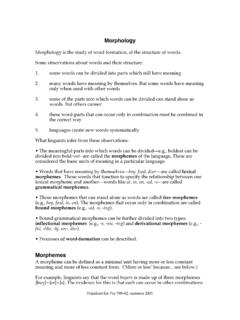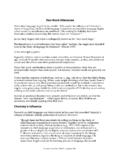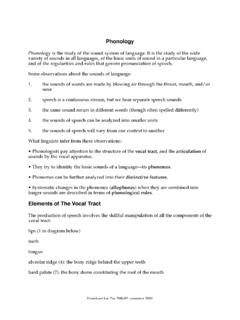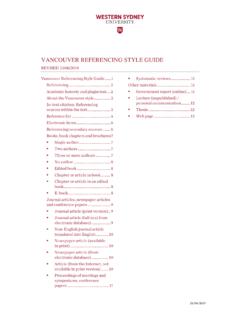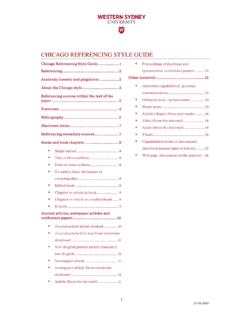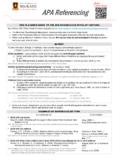Transcription of Morphology - Duquesne University
1 Handout for Psy 598-02, summer 2001 MorphologyMorphology is the study of word formation, of the structure of observations about words and their structure:1. some words can be divided into parts which still have meaning2. many words have meaning by themselves. But some words have meaningonly when used with other words3. some of the parts into which words can be divided can stand alone aswords. But others cannot4. these word-parts that can occur only in combination must be combined inthe correct way5. languages create new words systematicallyWhat linguists infer from these observations: The meaningful parts into which words can be divided , boldest can bedivided into bold+est--are called the morphemes of the language. These areconsidered the basic units of meaning in a particular language. Words that have meaning by themselves boy, food, door are called lexicalmorphemes. Those words that function to specify the relationship between onelexical morpheme and another words like at, in, on, -ed, -s are calledgrammatical morphemes.
2 Those morphemes that can stand alone as words are called free morphemes( , boy, food, in, on). The morphemes that occur only in combination are calledbound morphemes ( , -ed, -s, -ing). Bound grammatical morphemes can be further divided into two types:inflectional morphemes ( , -s, -est, -ing) and derivational morphemes ( , -ful, -like, -ly, un-, dis-). Processes of word-formation can be morpheme can be defined as a minimal unit having more or less constantmeaning and more of less constant form. ( More or less see below.)For example, linguists say that the word buyers is made up of three morphemes{buy}+{er}+{s}. The evidence for this is that each can occur in other combinationsPackerMorphology 2of morphemes without changing its meaning. We can find {buy} in buying, buys,and {er} in seller, fisher, as well as buyer. And {s} can be found in boys, girls, more combinations a morpheme is found in, the more productive it is said the terminology: Braces, { } indicate a morpheme.
3 Square brackets, [ ]indicate a semantic characterization. Italics indicate a lexical Morphemes can vary in size: neither the number of syllables nor the length ofa word can indicate what is a morpheme and what isn t. For example, Albatrossis a long word but a single morpheme, -y (as in dreamy ) is also a Just as linguists have had success dissecting phonemes into combinations ofdistinctive features, so they have viewed morphemes as made up ofcombinations of semantic features. For example, we can analyze a word likegirls in terms of both its morphological and its semantic structure:Morphological:girls = {girl} + {s}Semantic:{girl} = [-adult; -male; +human, ..] + {s} = {PLU} = [plural][More on this when we get to the topic of Semantics.]3. Two different morphemes may be pronounced (and even sometimes spelled)the same way. For example, the er in buyer means something like the one who, while the er in shorter means something like to a greater degree than.
4 The first er always attaches to a verb, while the second er always attaches to anadjective. It makes sense to consider these two different morphemes that justhappen to sound the same. (The first is called the agentive morpheme {AG} sinceit indicates the agent of an action; the second is called the comparativemorpheme {COMP} since it indicates the comparative degree of an adjective.)4. We can t always hold to the definition of a morpheme as having unchangingform. For example, when we consider words like boys, girls, shirts, books, weconclude that s is the plural morpheme (symbolized {PLU}.) But what aboutwords such as men or women? Here plurality is indicated not by adding s but bychanging the vowel in the stem. Yet we still want to say that men is,morphologically, {man} + {PLU}, even though the form of {PLU} is quite differentin this the same way, it seems sensible to say that went = {go} + {PAST}, just as walked= {walk} + {PAST}, even though in the first case {PAST} involves a morphologicalchange in form quite different from the usual adding of Sometimes it is very difficult to identify morpheme boundaries.
5 For example,the word hamburger originally meant {Hamburg} = a city in Germany + {er} =PackerMorphology 3 originating from. But probably most people now understand the word asmeaning {ham} = ham + {burger} = hot patty served on a round bun. Division of Morphemes into Various TypesLexical and Grammatical MorphemesLexical morphemes are those that having meaning by themselves (moreaccurately, they have sense). Grammatical morphemes specify a relationshipbetween other morphemes. But the distinction is not all that well , verbs, adjectives ({boy}, {buy}, {big}) are typical lexical , articles, conjunctions ({of}, {the}, {but}) are and Bound MorphemesFree morphemes are those that can stand alone as words. They may be lexicalmorphemes ({serve}, {press}), or grammatical morphemes ({at}, {and}).Bound morphemes can occur only in combination they are parts of a may be lexical morphemes (such as {clude} as in include, exclude, preclude) orthey may be grammatical (such as {PLU} = plural as in boys, girls, and cats).
6 PackerMorphology 4 Inflectional and Derivational MorphemesWe can make a further distinction within the set of morphemes that are bothbound and grammatical. Bound grammatical morphemes (those that don t havea sense by themselves and, additionally, always occur in combinations) arecommonly known as affixes. They can be further divided into inflectionalaffixes and derivational is some of the evidence for the distinction between inflectional andderivational affixes (the book has more):Inflectional AffixesDerivational AffixesAll are suffixesMay be either suffixes or prefixesHave a wide range of application. English nouns can be madeplural, with {PLU}May have a wide or narrow rangeAll native to English (since Old Englishwas spoken around 500-1000 AD)Many were adopted from Latin, Greek,or other languages. (Though others,especially the suffixes, are native,including {ful}, {like}, {ly}, and {AG})Inflectional AffixesEnglish has only eight inflectional affixes:{PLU} = pluralNoun-sboys{POSS} = possessiveNoun- sboy s{COMP} = comparativeAdj-erolder{SUP} = superlativeAdj-estoldest{PRES} = presentVerb-swalks{PAST} pastVerb-edwalked{PAST PART} = past participleVerb-endriven{PRES PART} = present participleVerb-ingdrivingNotice that, as noted above, even irregular forms can be representedmorphologically using these morphemes.
7 The irregular plural sheep iswritten as {sheep} + {PLU}, even though the typically form of {PLU} is not , better = {good} + {COMP}; drove = {drive} + {PAST}.Derivational AffixesThere are an indefinite number of derivational example, the following are some derivational suffixes:PackerMorphology 5{ize} attaches to a noun and turns it into a verb: rubberize{ize} also attaches to an adjective and turns it into a verb: normalize{ful} attaches to a noun and turns it into an adjective: playful, helpful{ly} attaches to an adjective and turns it into an adverb: grandly, proudlyA different {ly} attaches to a noun and changes it into an adjective: manly, friendlyEnglish also has derivational prefixes, such as:{un}, {dis}, {a}, {anti}, all of which indicate some kind of negation: unhappy, dislike,atypical, Affixes Again{PLU} plural nounds are repsented as root + {PLU}, whether or not {-s} isactually added to the root.{POSS} possessive nounds are root + {poss}, whether or not {-s} is added.
8 It s ahistorical accident that both these affixes sound the same.{COMP} and {SUP}. comparative and superlative adjtectives. happier = {happy}+ {COMP}; happiest = {happy} + {SUP}. Arguably, most beautiful = {beautiful} +{SUP}The remaining inflectional affixes are attached to verb stems, forming presentand past tenses, and present and past participles: webster s dictionary defines a participle as a word having the characteristics ofboth verb and adjective; especially an English verbal form that has the functionof an adjective and at the same time shows such verbal features as tense andvoice and capacity to take an object. Our examination of inflectional affixes thus leads us into a discussion of thevarious morphological forms that verbs can take, though this topic can t be fullyexplored until we deal with the topic of Tense{PRES} present tense forms are root + {PRES}. But there is only a surface affixwhen there is a 3rd person singular subject.
9 That s to say:John loves Mary = {love} + {PRES} = {love} + {-s}PackerMorphology 6 You love Mary = {love} + {PRES} = {love} + { }However, modal verbs can/could, , will/would, may/might andmust show an absense of this third person singular may love a modal verb occurs in a sentence, it is always ther first verb form and isalways followed by an uninflected verb Tense{PAST} past tense verb forms. John walked = {walk} + {PAST}.drove ={drive} + {PAST}In English, only the first verb form is inflected for tense. For example:I think; but I have thought; and I am thinking [??]Past Participle{PAST PART} driven = {drive} + {PAST PART}A past participle always follows a form of the auxiliary verb have (in a simpleactive sentence). (And if both a modal and the auxiliary have occur in the samesentence, have follows the modal: We may have have walked home, but not They walked home. [past tense]Gone, come, hit, walked are all past Participle{PRES PART} drinking = {drive} + {PRES PART}Present participles always occur with an -ing suffix.)
10 In a simple active sentence,the present participle always follows a form of the auxiliary verb to be, as in Theywere both the auxiliary have and the auxiliary be occur in the same sentence, theform of be always follows the form of have: We have been eating, not *We are FormsBelieve it or not, verbs in English are perfectly systematic. Consider:PackerMorphology 7 Someone may have been knocking at the door1. knocking is the main verb, since it is the right-most It is a present participle, because it immediately follows a form of been is an auxiliary verb, because it is not It is a past participle, because it immediately follows a form of have is an auxiliary verb, because it is not It is also uninflected, since it follows a modal (may).7. may is a modal, because it lacks the third person singular It is inflected for present tense, since the first and only the first verb in a simplesentence in English is inflected for Formation ProcessesObviously words don t make words, people make words!
